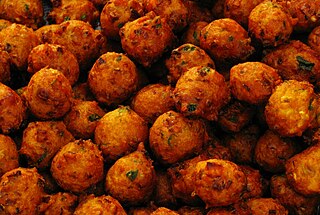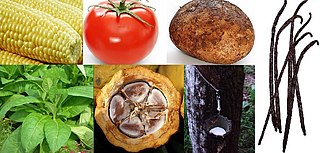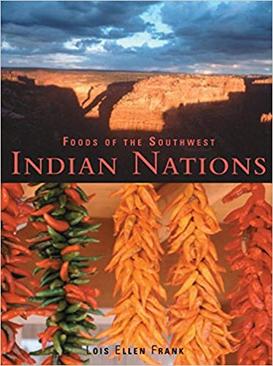
American cuisine consists of the cooking style and traditional dishes prepared in the United States of America. It has been significantly influenced by Europeans, indigenous Native Americans, Africans, Latin Americans, Asians, Pacific Islanders, and many other cultures and traditions. Principal influences on American cuisine are European, Native American, soul food, regional heritages including Cajun, Louisiana Creole, Pennsylvania Dutch, Mormon foodways, Texan, Tex-Mex, New Mexican, and Tlingit, and the cuisines of immigrant groups such as Chinese American, Italian American, Greek American and Mexican American. The large size of America and its long history of immigration have created an especially diverse cuisine that varies by region.

Soul food is an ethnic cuisine originating in the Southern United States historically pertaining to African-Americans. It originated from the cuisines of enslaved Africans trafficked to the North American colonies through the Atlantic slave trade during the Antebellum period and is closely associated with the cuisine of the American South. The expression "soul food" originated in the mid-1960s, when "soul" was a common word used to describe African-American culture. Soul food uses cooking techniques and ingredients from West African, Central African, Western European, and Indigenous cuisine of the Americas. Soul food came from the blending of what African Americans ate in their native countries in Africa and what was available to them as slaves. The cuisine had its share of negativity initially. Soul food was initially seen as low class food, and Northern African Americans looked down on their Black Southern counterparts who preferred soul food. The term evolved from being the diet of a slave in the South to being a primary pride in the African American community in the North such as New York City.

Tex-Mex cuisine is an American cuisine that derives from the culinary creations of the Tejano people of Texas. It has spread from border states such as Texas and others in the Southwestern United States to the rest of the country. It is a subtype of Southwestern cuisine found in the American Southwest.

A cookbook or cookery book is a kitchen reference containing recipes.

Bonda is a deep-fried South Indian potato snack that has various sweet and savory versions in different regions. The most common is aloo bonda, and other region-specific variations include potato replaced with sweet potato, tapioca, grated pineapple, green peas, paneer, or other ingredients.

Julia's Kitchen Wisdom is the final cookbook authored by chef and television personality Julia Child. Co-authored by David Nussbaum and edited by Judith Jones, the book covers basic cooking principles and techniques and was designed to serve as a reference point for amateur cooks. Julia's Kitchen Wisdom was the 17th book written by Child and gained widespread popularity following the release of the 2009 film, 'Julie and Julia'.

Frybread is a dish of the indigenous people of North America that is a flat dough bread, fried or deep-fried in oil, shortening, or lard.

Indigenous cuisine of the Americas includes all cuisines and food practices of the Indigenous peoples of the Americas. Contemporary Native peoples retain a varied culture of traditional foods, along with the addition of some post-contact foods that have become customary and even iconic of present-day Indigenous American social gatherings. Foods like cornbread, turkey, cranberry, blueberry, hominy and mush have been adopted into the cuisine of the broader United States population from Native American cultures.

Salade niçoise, salada nissarda in the Niçard dialect of the Occitan language, insalata nizzarda in Italian, is a salad that originated in the French city of Nice. It is traditionally made of tomatoes, hard-boiled eggs, Niçoise olives and anchovies or tuna, dressed with olive oil, or in some historical versions, a vinaigrette. It has been popular worldwide since the early 20th century, and has been prepared and discussed by many chefs. Delia Smith called it "one of the best combinations of salad ingredients ever invented" and Gordon Ramsay said that "it must be the finest summer salad of all".

Spoonbread is a moist cornmeal-based dish prevalent in parts of the Southern United States. While the basic recipe involves the same core ingredients as cornbread — namely cornmeal, milk, butter, and eggs — the mode of preparation creates a final product with a soft, rather than crumbly, texture. As the name implies, the consistency is soft enough that it needs to be served and eaten with a spoon.

New World crops are those crops, food and otherwise, that were native to the New World before 1492 AD and not found in the Old World before that time. Many of these crops are now grown around the world and have often become an integral part of the cuisine of various cultures in the Old World. Notable among these crops are the Three Sisters: maize, winter squash, and climbing beans.

Louis Felix Diat was a French-American chef and culinary writer. It is also believed that he created vichyssoise soup during his time at the Ritz-Carlton.
Whitney Leigh Miller Humphrey is an American chef who won the first season of the US version of MasterChef in 2010. Miller was named the first ever American MasterChef winner by MasterChef judges, Gordon Ramsay, Graham Elliot, and Joe Bastianich.

Corn stew is a stew prepared with corn (maize) as a primary ingredient. Many variations exist in ingredient usage and in methods of preparation. Corn stew is a dish in several cuisines of the world. Mazamorra is a historically old corn stew dish in South America that is prepared using simple ingredients, and is a dish in several other cuisines.

Iva Casuse Honwynum is a Hopi/Navajo artist, social activist, and cultural practitioner. A Native American, Honwynum is best known for her woven baskets and figurative sculpture. Honwynum's most important breakthrough was the development of the pootsaya basket, called "a rare innovation in Hopi basketry". She developed the pootsaya during her 2014 residency at the School for Advanced Research in Santa Fe, New Mexico, having been awarded the Eric and Barbara Dookin Artist Fellowship.

The Sioux Chef's Indigenous Kitchen is a recipe book written by Sean Sherman with Beth Dooley, published by the University of Minnesota Press in Minneapolis, Minnesota. Sean Sherman is an Oglala Lakota chef who was born in Pine Ridge, South Dakota, and is currently based in South Minneapolis. Sherman opened an Indigenous cuisine restaurant within the Water Works park development project overlooking Saint Anthony Falls and the Stone Arch Bridge in Minneapolis in 2021.

Original Local: Indigenous Foods, Stories and Recipes from the Upper Midwest is a recipe/collage book written by Heid E. Erdrich, published by the MN Historical Society Press in Minneapolis, Minnesota. Heid E. Sherman is a member of the North Dakota Turtle Mountain Band of the Ojibwe people who is currently based in South Minneapolis. Her cookbook explores native american cuisine and indigenous ingredients, within a globally-aware framework that includes stories, recollections and anecdotes.

Sean Sherman is an Oglala Lakota Sioux chef, cookbook author, forager, and promoter of indigenous cuisine. Sherman founded the indigenous food education business and caterer The Sioux Chef and cofounded with then-partner Dana Thompson the nonprofit North American Traditional Indigenous Food Systems (NĀTIFS). He received a James Beard Foundation Leadership Award and his 2017 cookbook, The Sioux Chef's Indigenous Kitchen, won the 2018 James Beard Award for Best American Cookbook. In 2022 the restaurant he co-owned with Thompson, Owamni, won the James Beard Award for Best New Restaurant.

Foods of the Southwest Indian Nations is a 2002 cookbook by Lois Ellen Frank, food historian, cookbook author, photographer, and culinary anthropologist. The book won a 2003 James Beard award, the first Native American cuisine cookbook so honored. CNN called it "the first Native American cookbook to turn the heads of James Beard Foundation award judges".
Loretta Barrett Oden is an American chef, Native foods historian, food writer, and television show host. She is an enrolled member of the Potawatomi tribe. She wrote and hosted the PBS series Seasoned With Spirit: A Native Cook's Journey. Oden writes a column, Spirit of the Harvest, for Native Peoples Magazine.



















